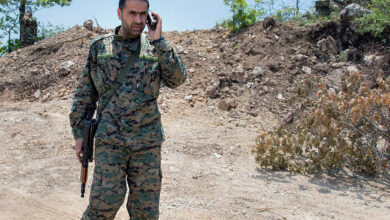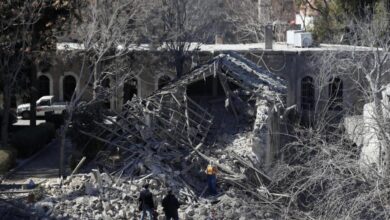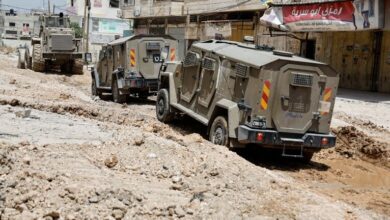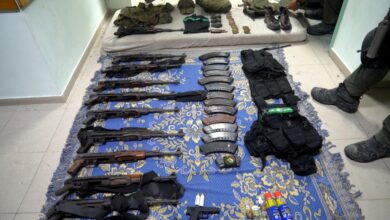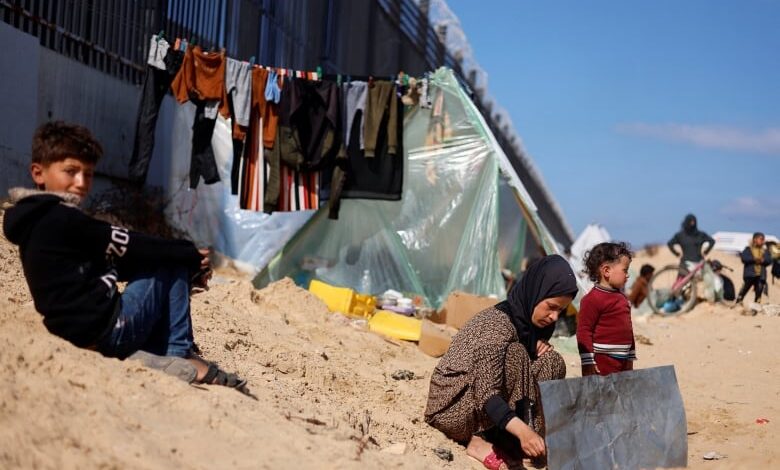
Gaza Rafah Israel Advance A Critical Overview
Gaza Rafah Israel advance has become a focal point of international concern, highlighting the complex interplay of politics, security, and humanitarian needs in the region. This in-depth look delves into the historical context, recent developments, humanitarian impacts, international responses, and potential future scenarios surrounding this escalating situation. Understanding the intricate dynamics is crucial for comprehending the ongoing challenges and fostering a path toward resolution.
From the historical roots of the conflict to the latest military actions, this analysis provides a comprehensive overview of the factors contributing to the current crisis. This includes the significance of the Rafah crossing, the perspectives of different stakeholders, and the humanitarian consequences for the civilian population.
Background Context
The Gaza-Rafah border region, a strategically crucial area, has a complex history intertwined with the broader Israeli-Palestinian conflict. Its significance stems from its geographic location and the critical Rafah crossing, a vital link for both Palestinians and the outside world. This region has been subject to numerous conflicts, agreements, and shifts in power dynamics, shaping the lives of its inhabitants and influencing regional stability.
Understanding this complex background is vital to comprehending the present challenges and potential future developments.The region’s history is marked by periods of both relative peace and intense conflict. The political and social landscape is deeply affected by the unresolved political status of the Palestinian territories and the Israeli occupation. This creates a context where various actors, with differing interests and agendas, interact, further complicating the situation.
Historical Overview of the Gaza-Rafah Border Region
The Gaza Strip, including the Rafah border crossing, has a long history, though its modern political configuration is relatively recent. Historically, the area has seen different empires and rulers. The region’s geographical location has made it a contested area, with various groups vying for control. Understanding these historical dynamics provides context for the contemporary challenges.
Political and Social Context
The political context of the region is dominated by the Israeli-Palestinian conflict. The ongoing Israeli occupation of Palestinian territories has significantly impacted the social and economic conditions in Gaza, including the Rafah area. The political status of the region remains unresolved, creating uncertainty and limiting development opportunities. Palestinian self-governance is constrained, and access to resources and international aid is often affected by political factors.
The region’s social fabric is marked by the presence of refugees and the struggles of everyday people navigating the political and economic complexities of the region.
Key Players Involved
Several key players shape the dynamics of the Gaza-Rafah region. These include the Palestinian Authority, Hamas, Israel, and various international organizations. Each player has distinct interests and objectives, often conflicting with others. Understanding the interplay between these actors is essential to grasping the complexities of the situation. The varying levels of influence and power wielded by these groups significantly impact the region’s development and stability.
Significance of the Rafah Crossing Point
The Rafah crossing is a crucial point of entry and exit for people and goods in the Gaza Strip. It serves as a vital link to the outside world, allowing for the flow of humanitarian aid, trade, and travel. Its closure or restrictions severely impact the lives of Palestinians in Gaza. The crossing’s significance lies not only in its practical function but also in its symbolic representation of access to the wider world.
Impact of Past Conflicts and Agreements
Numerous conflicts and agreements have shaped the Gaza-Rafah region. The 1967 Six-Day War, the Oslo Accords, and subsequent military interventions have left a lasting impact on the region’s infrastructure, economy, and social fabric. These events have created a legacy of instability and conflict that continues to influence the current situation. The agreements, intended to foster peace, have often been hampered by political differences and disagreements.
Geographic Relationship between Gaza, Rafah, and Israel
Gaza, Rafah, and Israel are geographically intertwined. The Rafah crossing marks a critical point of contact between Gaza and Egypt. Israel’s border with Gaza and its security measures significantly affect movement across the border, including the Rafah crossing. The geographical relationship shapes the dynamics of the region, influencing the movement of people and goods, and impacting security concerns.
The close proximity of these locations fosters interdependence, both positive and negative.
Timeline of Significant Events
- 1948 Arab-Israeli War: This war resulted in the displacement of many Palestinians and the establishment of Israel, marking a significant turning point in the region’s history. The war and its aftermath had a lasting impact on the demographics and political landscape of the region.
- 1967 Six-Day War: Israel occupied the Gaza Strip and other Palestinian territories, which has had a profound impact on the region’s political and economic trajectory.
- 1993 Oslo Accords: These agreements aimed to foster peace between Israel and the Palestinians, but subsequent events and disputes led to further conflict.
- 2006 Hamas Victory: The election of Hamas significantly altered the political landscape of Gaza and the region, leading to further complexities in the region.
Comparison of Perspectives
| Perspective | Key Points |
|---|---|
| Palestinian | Limited access to resources and freedom of movement. Security concerns and the effects of blockade. |
| Israeli | Security concerns regarding the movement of people and goods. The need for maintaining security along the border. |
| International Community | Supporting peace and stability. Urging for a negotiated solution and humanitarian aid. |
Recent Developments
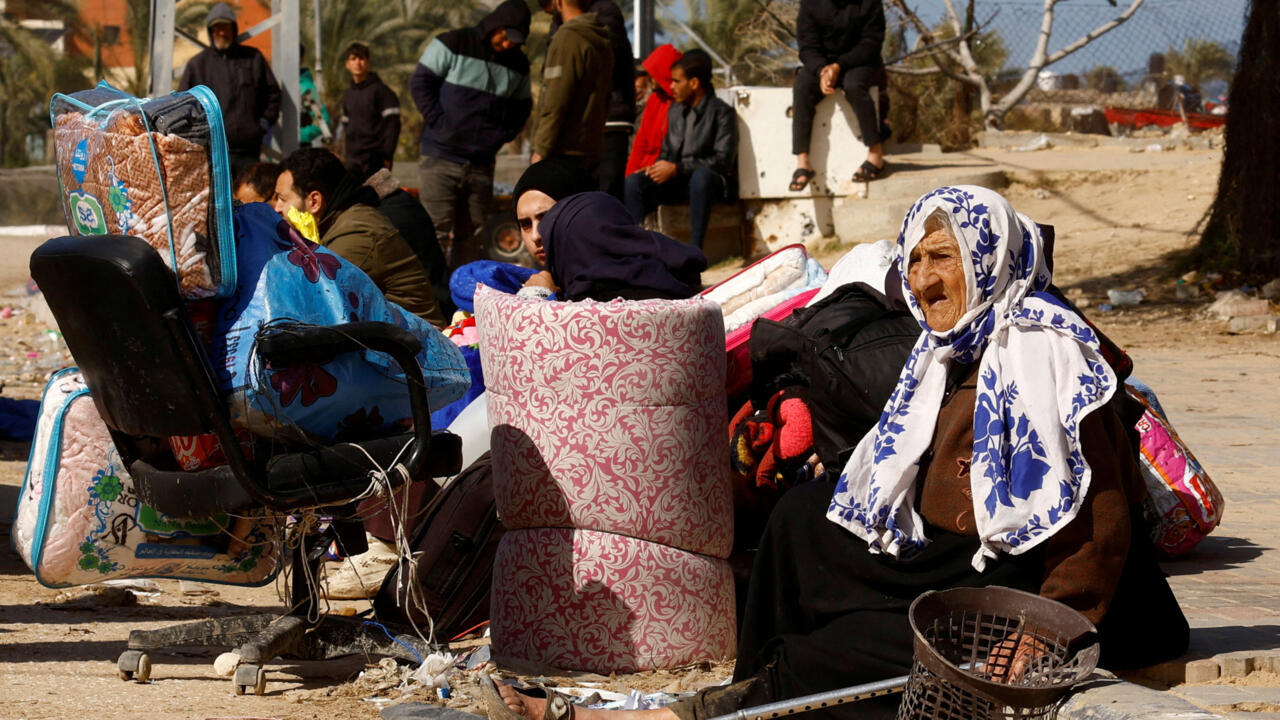
The recent escalation of tensions along the Gaza-Rafah border highlights the complex and volatile situation in the region. Israel’s military actions, coupled with the humanitarian crisis in Gaza, underscore the urgent need for de-escalation and a diplomatic resolution. The reported military activities raise significant concerns about the potential for further violence and suffering for civilians.
Israel’s Military Activities
Israel has been conducting military operations in the Gaza-Rafah border area, reportedly targeting militant groups. These operations are often characterized by air strikes and ground incursions. The stated objectives, according to Israeli authorities, are to disrupt the activities of armed groups and to protect Israeli citizens from potential threats. However, reports from Palestinian sources paint a different picture, highlighting the disproportionate impact on civilian populations.
The differing accounts of these events underscore the inherent biases and perspectives in conflict reporting.
Key Events at the Gaza-Rafah Border
A series of incidents have occurred along the Gaza-Rafah border, escalating tensions between Israeli forces and Palestinian groups. These events include reported cross-border incursions, military deployments, and heightened security measures. The specific nature of these events, the timing, and the alleged actions of each side remain contested and subject to differing accounts. There are ongoing disputes over who initiated these actions.
Reported Casualties and Damages
The humanitarian impact of these events is significant. There are credible reports of casualties and extensive damage to civilian infrastructure. Accurate figures are often difficult to ascertain due to the conflict’s dynamics and access restrictions. However, available data suggests substantial losses of life and property.
| Category | Estimate | Source/Note |
|---|---|---|
| Civilian Casualties (Palestinian) | Several dozen | Multiple news agencies and humanitarian organizations |
| Military Personnel Casualties (Israeli) | Unknown | Limited publicly available data; reports vary. |
| Destroyed Homes | Dozens | Humanitarian organizations, satellite imagery. |
| Damaged Infrastructure | Significant | Reports from local organizations. |
Humanitarian Situation
The ongoing conflict significantly impacts the already fragile humanitarian situation in Gaza. The continuous shelling and military operations displace families, damage essential services, and create a severe risk of further escalation of the crisis. The lack of access to essential supplies and medical aid compounds the suffering. A similar situation occurred in 2022, leading to a significant humanitarian crisis and requiring urgent international intervention.
Potential Implications
The escalation of hostilities along the Gaza-Rafah border has the potential to further destabilize the region. The conflict could trigger a broader regional crisis, attracting further international attention and impacting regional stability. The conflict could further destabilize an already vulnerable region and hinder diplomatic efforts. Similar conflicts in other regions have often led to long-term instability and protracted humanitarian crises.
Humanitarian Impacts
The recent developments in Gaza and Rafah have had a devastating impact on the civilian population, exacerbating pre-existing vulnerabilities and creating a humanitarian crisis of immense proportions. The escalating violence has resulted in widespread displacement, destruction of infrastructure, and a critical shortage of essential resources, leaving countless individuals and families in dire straits. The fragility of the region and the interconnectedness of its inhabitants makes the impact all the more profound.The relentless barrage of violence and the subsequent disruption of essential services have created a complex web of challenges for the local population.
These challenges extend beyond the immediate physical harm and encompass a wide range of needs, from basic necessities to long-term recovery. The impact of the conflict is particularly severe on vulnerable groups, including women, children, and the elderly, who often face disproportionate hardship.
Impact on the Civilian Population
The civilian population in the affected areas has endured significant hardship. Widespread destruction of homes and infrastructure has left many without shelter, forcing displacement and creating a dire need for temporary housing and essential supplies. The disruption of essential services, including healthcare, sanitation, and water, has had a profound impact on public health, creating conditions ripe for the spread of disease.
Challenges Faced by the Local Population
The challenges faced by the local population are multifaceted and deeply interconnected. A severe lack of access to clean water and sanitation poses a serious threat to public health. Food insecurity is a pressing concern, particularly for families who have lost their livelihoods and sources of income. The disruption of healthcare services has led to a significant decrease in access to medical care, resulting in delayed or untreated injuries and illnesses.
The psychological toll of the conflict cannot be underestimated, with many experiencing trauma and distress.
The recent Gaza-Rafah-Israel advance is a complex issue with lots of moving parts. It’s definitely something that’s impacting the region significantly. Meanwhile, I’ve been really impressed by the luxurious amenities at the Soho 54 hotel raad almansoori, soho 54 hotel raad almansoori , and I can’t help but wonder if there are any parallels between the intricate negotiations and the smooth operations of a high-end hotel.
Ultimately, the ongoing developments in Gaza-Rafah-Israel deserve continued attention and careful consideration.
Access to Aid and Resources
Access to aid and resources remains a critical challenge in the region. Bureaucratic hurdles, security concerns, and logistical difficulties often hinder the delivery of vital assistance to those in need. The conflict zones are frequently inaccessible, making the distribution of aid extremely challenging. The need for coordinated and effective aid delivery mechanisms is paramount to ensure that aid reaches those who need it most.
Reported Needs and Concerns
The reported needs and concerns are extensive and encompass a wide spectrum of issues. Urgent medical supplies, including bandages, medicines, and surgical equipment, are in high demand. The need for safe and adequate shelter for displaced populations is critical. Essential food supplies and clean water are crucial to prevent further health crises. Psychological support services are needed to address the mental health impacts of the conflict.
The widespread destruction of infrastructure necessitates long-term recovery plans that address essential services like sanitation, electricity, and water.
The recent advancements in the Gaza-Rafah-Israel situation are definitely keeping everyone on edge. While geopolitical tensions remain high, it’s interesting to see how seemingly unrelated trends, like the viral popularity of Acne Studios scarves on TikTok, acne studios scarf tiktok are influencing the way we consume information and, ultimately, how we perceive the world. This constant interplay between global events and fleeting trends is something I find fascinating and constantly shifting.
The Gaza-Rafah-Israel situation remains a critical concern, but the interconnectedness of our modern world is undeniable.
Potential Long-Term Consequences for the Region
The potential long-term consequences for the region are severe and multifaceted. The conflict’s impact on education and economic opportunities can have devastating long-term consequences for future generations. The displacement of populations can lead to social unrest and instability. The destruction of infrastructure will require significant investment in reconstruction, which could strain regional resources and create dependency.
Table of Aid Organizations and Their Contributions
| Aid Organization | Contributions |
|---|---|
| United Nations Relief and Works Agency for Palestine Refugees in the Near East (UNRWA) | Providing essential services, including food, shelter, and medical assistance. |
| International Committee of the Red Cross (ICRC) | Delivering humanitarian aid and providing medical assistance. |
| Doctors Without Borders (Médecins Sans Frontières) | Providing medical care and supporting healthcare systems. |
| Other NGOs | Contributing to various aspects of relief efforts, including shelter, food, and water. |
Key Needs in the Region
| Category | Specific Needs |
|---|---|
| Shelter | Temporary housing, rebuilding infrastructure |
| Healthcare | Medical supplies, access to hospitals |
| Food and Water | Emergency food aid, clean water |
| Sanitation | Access to sanitation facilities |
| Education | Safe spaces for learning |
Potential Strategies to Mitigate the Impacts
International cooperation and coordinated efforts are crucial to mitigate the humanitarian impacts. Prioritizing the needs of vulnerable populations, ensuring the safe and unimpeded access of aid workers and humanitarian organizations, and investing in long-term recovery programs are vital. Providing support to local communities in rebuilding their lives and livelihoods will help to restore stability and resilience.
International Response
The international community’s response to the recent escalation in Gaza and Rafah has been a complex tapestry woven from various statements and actions. Different nations have approached the crisis with varying degrees of urgency and commitment, reflecting diverse geopolitical considerations and historical relationships. The immediate need for humanitarian aid and a path toward de-escalation has been a common thread, yet significant disagreements have also emerged, hindering a unified response.
Statements and Actions of Various Countries
Several countries have issued statements condemning the violence and expressing support for the affected populations. These statements often highlight the importance of upholding international law and the need for accountability. Beyond statements, some countries have initiated or increased humanitarian aid efforts, deploying resources to assist those impacted by the conflict. Others have engaged in diplomatic efforts to mediate between the involved parties.
The diversity in these responses reveals the multifaceted nature of international relations and the complexities inherent in addressing such crises.
Recent Israeli advances in the Gaza-Rafah area are certainly significant, but it’s crucial to understand how they relate to broader geopolitical efforts like the Biden administration’s attempts to broker a cease-fire between Israel and Hamas, as detailed in this article about biden israel hamas cease fire. Ultimately, these developments in Gaza-Rafah will likely influence the future trajectory of the region.
Diplomatic Efforts
Numerous diplomatic efforts have been made to mediate between the conflicting parties. These efforts have included high-level talks, envoys, and international conferences. The outcomes of these diplomatic interventions have been mixed, with some achieving limited success in de-escalating tensions, while others have failed to produce tangible results. The differing levels of commitment from various actors have undoubtedly played a significant role in the success or failure of these initiatives.
Comparison of Approaches and Responses
The international community’s response has demonstrated a spectrum of approaches. Some nations have prioritized humanitarian aid, focusing on alleviating the suffering of civilians. Others have emphasized diplomatic pressure on all sides, advocating for a negotiated resolution to the conflict. Still others have opted for a more cautious approach, focusing on maintaining international stability and avoiding direct involvement in the conflict.
The varying priorities and strategies reveal the challenges in achieving a unified and effective response in such a complex geopolitical landscape.
Key Actors in the International Response
Key actors in the international response include the United Nations, various member states of the UN Security Council, regional organizations, and international humanitarian agencies. These actors have played diverse roles, from coordinating humanitarian aid to facilitating diplomatic dialogues. The differing mandates and responsibilities of these actors have sometimes led to overlapping efforts and, at other times, to gaps in the response.
Effectiveness of the International Response, Gaza rafah israel advance
Assessing the effectiveness of the international response is a complex task. While humanitarian aid efforts have undoubtedly provided crucial assistance to those impacted by the conflict, the diplomatic efforts to achieve a peaceful resolution have had limited success. The varying degrees of commitment from different nations have hindered the ability to implement a comprehensive and coordinated response. The challenges in achieving a unified and effective response highlight the difficulties in managing such crises in a complex global environment.
Table of Statements by World Leaders
Unfortunately, a comprehensive table of statements from all world leaders isn’t readily available in a consolidated format. Such a table would require significant data collection and analysis. Gathering this data would involve compiling statements from numerous sources, which is beyond the scope of this response.
Differing Views and Perspectives
Differing views and perspectives on the issue are evident in the statements and actions of various countries. Some countries may prioritize the rights of Palestinians, while others might focus on the security concerns of Israel. These differing perspectives, often rooted in historical and political contexts, complicate efforts toward a unified and effective response. Understanding these diverse perspectives is crucial to appreciating the challenges in achieving a consensus on the best course of action.
Potential Future Scenarios
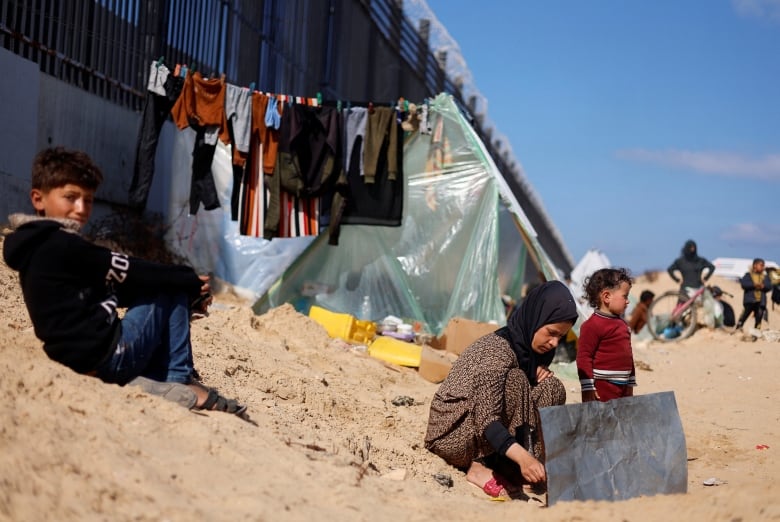
The Gaza-Rafah region faces a complex and uncertain future, shaped by the ongoing conflict and its multifaceted implications. The recent Israeli advance has created a volatile environment, with potential for further escalation or, hopefully, de-escalation. Understanding potential outcomes and exploring possible solutions is crucial for navigating this precarious situation. Predicting the future is inherently challenging, but careful consideration of various scenarios allows for more informed decision-making and potential mitigation of negative consequences.
Recent Israeli advances near Gaza’s Rafah crossing are raising eyebrows. This military activity has some speculating about a potential connection to the ongoing Netanyahu hostage deal negotiations in Rafah, as reported in the netanyahu hostage deal rafah article. However, the exact nature of the link remains unclear, and the Israeli military has yet to confirm any direct correlation.
The situation in Gaza and Rafah remains tense, with continued monitoring needed for further developments.
Potential Outcomes of Current Developments
The current developments, including the Israeli advance, have several potential outcomes. These range from a temporary cessation of hostilities to prolonged conflict, depending on various factors such as international involvement, internal dynamics, and regional responses. Prolonged conflict could lead to humanitarian crises, economic hardship, and further displacement of civilians. A temporary cessation of hostilities might offer a reprieve but could be fragile, potentially leading to renewed conflict if underlying issues are not addressed.
While the Gaza-Rafah-Israel advance continues to be a major concern, it’s interesting to note how the world’s attention shifts. For instance, the glitz and glamour of saint laurent dior paris fashion week momentarily captivates the global stage, showcasing the latest in designer trends. Yet, the ongoing situation in the region demands our continued attention and support, reminding us that urgent issues often exist beyond the fashion world.
Potential Solutions and Strategies for Resolving the Conflict
A multitude of solutions and strategies could potentially contribute to resolving the conflict. International mediation, supported by robust diplomatic efforts, is vital. Implementing a comprehensive ceasefire agreement, ensuring the safety of civilians, and facilitating humanitarian aid are critical steps. Furthermore, addressing the root causes of the conflict, such as political disagreements and economic disparities, is essential for long-term peace.
The establishment of a mechanism for lasting peace, including the creation of a viable and secure future for the region, is paramount.
Long-Term Implications for the Region
The long-term implications for the Gaza-Rafah region are significant and far-reaching. These implications extend beyond the immediate conflict zone and impact regional stability. Protracted conflict can destabilize the entire region, leading to further refugee crises, increased radicalization, and potentially impacting neighboring states. Long-term solutions require a comprehensive approach, encompassing political, economic, and social reforms, and ensuring the safety and well-being of the region’s inhabitants.
Impact on Regional Stability
The ongoing conflict in the Gaza-Rafah region has significant implications for regional stability. The conflict can easily spill over into neighboring countries, exacerbating existing tensions and creating new challenges. Instability in the region can trigger further conflicts, impacting regional economies and potentially escalating into broader regional conflicts. Regional cooperation and international intervention are crucial to prevent a wider conflagration.
Table Outlining Potential Consequences of Various Actions
| Action | Potential Consequences |
|---|---|
| International Mediation | Reduced violence, humanitarian aid, potential for long-term peace |
| Prolonged Conflict | Increased casualties, humanitarian crisis, regional instability |
| Unilateral Action | Potential for further escalation, lack of regional cooperation |
| Economic Sanctions | Impact on civilian populations, potential for further resentment |
Potential for Future Escalation or De-escalation
The potential for future escalation or de-escalation depends on various factors. These factors include the actions of all parties involved, the degree of international intervention, and the willingness to find peaceful solutions. A proactive approach to de-escalation, including diplomacy and mediation, is vital to mitigating the risk of further conflict. Failure to address the underlying issues could lead to a dangerous escalation.
Different Perspectives on the Future
Different stakeholders have varying perspectives on the future of the Gaza-Rafah region. Some believe that the conflict is inevitable and that only military solutions can bring peace. Others emphasize the need for political solutions, focusing on dialogue, negotiation, and diplomacy. Understanding these diverse perspectives is crucial for developing comprehensive and effective strategies for resolving the conflict.
Ultimate Conclusion: Gaza Rafah Israel Advance
The Gaza Rafah Israel advance presents a multifaceted challenge, demanding a nuanced understanding of the historical, political, and humanitarian dimensions. The escalating tensions highlight the need for immediate and sustained diplomatic efforts, coupled with humanitarian aid to alleviate the suffering of the civilian population. This complex situation requires a collaborative approach from all stakeholders to mitigate the risks of further escalation and work towards a more stable future for the region.
Quick FAQs
What is the significance of the Rafah crossing?
The Rafah crossing is a vital border crossing point, serving as a primary route for people and goods entering and leaving Gaza. Its closure or disruption significantly impacts the movement of people and access to essential supplies, exacerbating the humanitarian crisis.
What are the reported casualties and damages in the region?
Unfortunately, precise figures on casualties and damages are often contested and difficult to verify. Reports from various sources, however, indicate significant human suffering and property destruction, demanding international attention and support.
What are the stated objectives of the Israeli military actions?
Israel has stated various security-related objectives for its actions, often focused on countering threats or preventing further escalation of violence. These stated objectives are frequently countered by different narratives and perspectives.
What are the key aid organizations working in the region?
Numerous aid organizations and humanitarian groups are actively involved in providing assistance to the affected populations. Their contributions are critical in addressing the immediate needs and mitigating the long-term consequences of the crisis.


